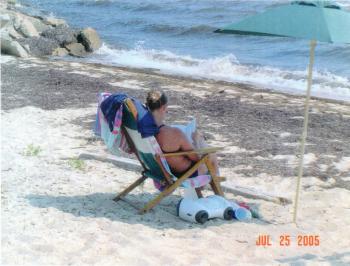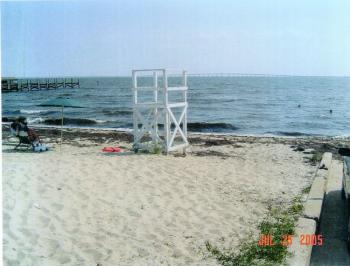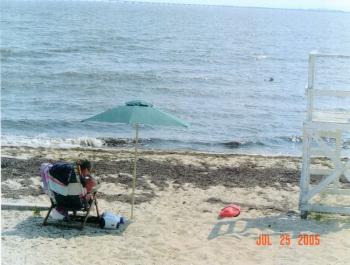Stewart v. Sandski, Surf Rescue, and Dare County (North Carolina)



On July 21, 2005, at approximately 3:00 PM, 8-year-old Cortez Stewart was swimming at the Mateo beach, typically referred to as “The Old Swimming Hole” in Dare County, North Carolina. He was accompanied by his older brother, Ben, and his cousin, Tierra Wilkins, and they were in the water in front of the lifeguard stand. There were approximately four additional swimmers in the water at the time. The weather was clear, but the winds were strong resulting in increased wave action. Neither Cortez or his family had been to this location previously. A lifeguard was seated on the lifeguard stand, approximately 5 – 10 yards from where Cortez, his brother and cousin were swimming.
Cortez, his brother, and cousin became distressed in the water when they were sucked out intot he water a few feet over a sharp drop-off by a wave, and lost their footing. While struggling to keep their heads above the water’s surface, they were bouncing on the bottom and screaming for help. In her panic, Tierra was holding onto Cortez for support in her effort to keep her head out of the water.
After several minutes the older brother was able to move closer to the lifeguard stand and continued to attempt to attract the Lifeguard’s attention. However, it was reported that the lifeguard was asleep in the stand. The lifeguard admits to having been listing to music while on duty with headphones on. She was unresponsive to the calls for help from the three children.
When the older brother reached, awoke, and alerted the lifeguard, she ran out to investigate the incident, leaving her rescue buoy on the beach. She also failed to communicate via radio the fact she was leaving her post to enter the water for a possible rescue.
When the lifeguard reached Tierra, she was extremely panicked, while Cortez was still struggling at the water’s surface. The lifeguard brought Tierra into shallower water and then proceeded back out to Cortez who had subsequently submerged below the surface. After repeated surface dives in her attempt to locate Cortez, she then instructed Ben to retrieve her rescue buoy from the beach.
Fire, Rescue, and Law Enforcement personnel were finally dispatched when Cortez’ mother phoned 911 for help. Cortez was recovered 45 minutes later by divers.
Upon evaluation of this incident, it was the expert’s opinion that the lifeguard, Dare County, and the lifeguard agency, Surf Rescue, breached the Standard of Care in a number of ways that contributed or caused this tragic incident.
Lifeguard training programs are typically designed to provide lifeguard candidates with the skills and knowledge necessary to keep patrons engaged in aquatic recreation activities safe while in and around the water. The focus of these training programs is on the prevention, recognition, and management of submersion and aquatic injury incidents.
According to the United States Lifesaving Association (USLA), as well as other training organizations, it is the responsibility of the hiring organization to conduct site-specific pre-service and continuous in-service training of the lifeguard personnel. Furthermore, the USLA recognizes three major modes of training – prerequisite, pre-service, and in-service.
Yet, the total training provided by Surf Rescue to train and “qualify” their lifeguards consisted of 41.25 hours of instruction that included skill evaluations and physical training (6 hours) and facility tours (6 hours), although no tour was conducted of “The Ole Swimming Hole”. These training components are typically considered as part of the site-specific pre-service training and are not usually part of the curriculum instructional hours. Therefore, when reviewing the 2005 Surf Rescue schedule to train and qualify their lifeguards, only about 35 hours were dedicated to lifeguarding instruction. It was not clear what emphasis was placed on surveillance protocols and victim recognition, but when reviewing the OPEN WATER RESCUE MANUAL for Duck and Southern Shores Surf Rescue, there is very little information provided on these subjects and only 7-hours of the 41.25 curriculum hours is spent reviewing/discussing the contents of this manual.
The Duck and Southern Shores OPEN WATER RESCUE MANUAL identifies pre-employment standards for lifeguards according to USLA regulations, as well as post-training requirements. However, because the lifeguard was currently certified as a Paramedic, she was not required to participate in the post-training after her initial 41.25 hours of instruction.
According to Standard Operating Guidelines 4-2 Equipment of the OPEN WATER RESCUE MANUAL, each lifeguard is assigned equipment consisting of a rescue buoy, binoculars, fins, radio, umbrella, whistle, and water cooler. However, on the day of this incident, the lifeguard was using an unassigned piece of equipment, namely a CD music player and earphones, and did not have a radio for emergency communications, nor did she have her assigned whistle.
According to Standard Operating Guidelines 4-3 Communications, “Lifeguards should make efforts to talk with the people to make them aware of any possible hazards.” Yet, although the lifeguard recognized the fact that Cortez, his cousin, and brother were progressing into deeper water, she failed to assess their skills and failed to call them in to shallower water; and she failed to warn them of the hazards and risks associated with this body of water.
This same SOG discusses radio communications protocols, although the lifeguard did not have a radio while on duty at this beach, and was totally dependent upon the use of her personal cell phone to communicate with her superiors and to call for backup.
SOG 4-4 Rescues outlines the responsibilities of the lifeguard personnel to identify potential hazards and problems and when to respond to an incident after alerting the “next immediate superior” and “advise of the situation and location.” However, once the lifeguard was alerted of the incident, she failed to notify anyone prior to leaving her post, and then entered the water without calling for backup, which resulted in an unreasonable delay in initiating the search for Cortex once he submerged below the surface.
Section 5-1 of their manual stresses the lifeguard’s foremost responsibility is to WATCH THE WATER, and that “taking your eyes away from the water will endanger the lives of those whom you are responsible for.” Yet, it was reported that the lifeguard, besides listening to music with her earphones, was actually asleep in her stand and, obviously, inattentive to the cries for help and signs of distress as displayed by Cortez, his cousin, and his brother prior to Cortez’ submersion below the water’s surface.
This section of the manual also discusses very elementary SCANNING procedures, which evidently, the lifeguard failed to follow. Just as importantly, however, this section of the manual discusses “fatigue as an important cause of deterioration of the lifeguard’s scanning…” and that the lifeguard should “receive sufficient breaks” to stay alert and to prevent boredom, eyestrain, sun, and wind exposure, etc. However, this lifeguard was the only lifeguard assigned to this beach and no breaks were provided during her shift.
The manual also discusses victim recognition (Swimmer Observation). Although the surviving children described these actions once they got into trouble, the lifeguard failed to recognize any of these signs due to her inattentiveness.
The manual discusses the Emergency Response Plan that is supposed to be followed “once a potential rescue has been established”. However, due to the lifeguard’s inappropriate training, she failed to follow these protocols which resulted in a delay in backup as well as the search and rescue of Cortez once he submerged below the water’s surface.
Based on the review of all materials, it seemed evident that the lifeguard was inappropriately trained, evaluated, and supervised. Surf Rescue had a duty to provide vigilant and effective lifeguard services at “The Ole Swimming Hole”. However, their lifeguard training program was obviously entirely ineffective, and their operational protocols were deficient. Dare County assessed the nee to require lifeguard services at this beach and established criteria for their vendor (Surf Rescue) to provide these services. However, they failed to require Surf Rescue to meet the established criteria and they failed to assess Surf Rescue’s ability to meet this criteria as well as to hold them accountable to do so.
During the lifeguard’s initial training as provided by Surf Rescue, tours were conducted on the pier, beach, and other locations, but no tour was provided of this particular beach facility. Typically, as part of the pre- and in-service training, the “tour” of the facility would include an identification of the hazards and risks associated with the beach facility, as well as methods to supervise and survey the beach and its patrons. But, no such tour was included for this particular beach facility.
Surf Rescue lists the equipment which is supposedly issued to each lifeguard. Yet, according to the lifeguard, she was not issued a whistle and stated that a whistle, “is not required”. Yet, to get the attention of bathers and to warn them of possible dangerous situations, the whistle is a critical piece of rescue/safety equipment. If the lifeguard had observed the children progressing into deeper water, she had no mechanism by which to communicate to them to order them back to shallower water.
Lifeguards need to anticipate the rscue and must remain alert to recognize signs of distress or drowning. Once the recognition is made, after alerting superiors and/or other lifeguards of the need to leave her post to effect the rescue, the lifeguard must immediately respond. However, the lifeguard was not immediately available to respond to the incident as she was wearing shorts while on duty and her response was delayed as she had to remove her shorts before running and swimming out to respond to this incident.
Although Surf Rescue developed an SOG on water rescue protocols, the lifeguard failed to communicate with her superiors and/or other lifeguards prior to entering the water. Due to her lack of training and supervision, she also failed to take her rescue buoy into the water with her. Because of Cortez’ cousin’s panic and the fact that the lifeguard did not have her rescue buoy with her, the lifeguard’s full attention was focused on bringing her to shallower water while trying to keep her from overpowering the lifeguard. This resulted in the lifeguard’s inability to keep track of Cortez before he submerged and therefore was not able to identify a last seen point once he did submerge below the water’s surface. Had the lifeguard entered the water with her rescue buoy, she could have placed the girl on the buoy and then concentrated her efforts on rescuing Cortez. Or, because of the high buoyancy of the rescue buoy, she could have rescued both children with this device before Cortez submerged.
Besides providing deficient training to this lifeguard, Surf Rescue and Dare County failed to conduct a threat assessment of “The Ole Swimming Hole” and failed to assess the staffing needs of this beach facility. Furthermore, they provided no supervision to the lifeguard while she was working at this beach, and provided no breaks for the lifeguard in order to keep her vigilant, attentive, and alert.
The lifeguard indicated the children were swimming in water beyond their abilities. However, the first responsibility of a lifeguard is to prevent the incident from occurring in the first place. If she recognized the fact the children were in water beyond their ability, it was her responsibility to communicate with them and to require them to move closer into shallower water. However, the lifeguard failed to do this and instead claims that Cortez contributed to his own death. She also claims another contributing factor was a “lack of parental supervision”. Had the lifeguard acted reasonably and appropriately and had she recognized the fact there were children with poor swimming skills venturing into deep water, and that no parental supervision was evident, then it was her responsibility to require these children to come back into safer and shallow water depths.
As a proximate result, Cortez Stewart died from his unrecognized submersion on July 21, 2005. This incident could have and should have been prevented had an appropriately trained, qualified, and vigilant lifeguard been on duty to recognize his initial signs of distress and to intervene before his submersion. And, because of Surf Rescue’s failure to staff this beach with trained, qualified, and vigilant lifeguard personnel, as well as their failure to develop and implement appropriate Emergency Response Plans, there was an exceptionally long delay in the response of rescue personnel to search and rescue Cortez, which resulted in his death.


